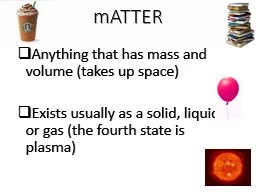

mATTER Anything that has mass and volume takes up space Exists usually as a solid liquid or gas the fourth state is plasma Characteristics Properties of Matter Matter has many characteristics properties that can be observed ID: 762067
Download Presentation The PPT/PDF document "mATTER Anything that has mass and volume..." is the property of its rightful owner. Permission is granted to download and print the materials on this web site for personal, non-commercial use only, and to display it on your personal computer provided you do not modify the materials and that you retain all copyright notices contained in the materials. By downloading content from our website, you accept the terms of this agreement.
mATTER Anything that has mass and volume (takes up space)Exists usually as a solid, liquid or gas (the fourth state is plasma)
Characteristics (Properties) of MatterMatter has many characteristics (properties) that can be observed: Physical (observed without changing the make up of the substance)Mass VolumeDensityColor Shape/sizeTexture
More Physical PropertiesConductor of electricityHardness of a mineralStreak of a mineralCleavage of a mineral OdorMelting/freezing/boiling pointSolubility
Physical ChangesA change in a physical property without changing the make up of the substance Examples include:Ripping paperCutting a piece of yarnStretching a rubber bandPhase changes (water boiling, freezing and melting)Sheep-sheeringSeparating a mixture (by physical means)
Characteristics of Physical Changes The substance is the SAME before and after Only the physical properties changeA physical change CAN be reversed
Chemical ChangesMatter has many characteristics (properties) that can be observed: Chemical (describe how substances can form new substances)CombustibilityAbility to rustTarnishingpH
Chemical ChangesA change in a substance that produces one or more new substancesExamples includeNail rusting Wood burningFood cookingTarnishing of the Statue of LibertyPhotosynthesis
Evidence of a Chemical ChangeLook for:color changebubbling and fizzing (a gas is produced) light or heat production (the release of energy)formation of a solid.
Characteristics of Chemical Changes Substance changes into something else (it is NOT the same before and after)Both physical and chemical properties changeA chemical change can NOT be reversed
SOOOOOOOO……WHERE DO WE BEGIN!?!?!?
Mass The amount of matter an object containsMeasured with a triple beam balanceUnit (symbol)Gram (g)
Volume Amount of space a substance takes up ObjectIrregular solids and liquidsRegular solid Measured withGraduated cylinderMetric rulerUnit (symbol)Liter (L) Cubic Centimeter (cubic cm)
Density A property of matter representing the mass per unit volumeD= m/v Unit (symbol)g/cm3 or g/mL “how jam-packed something is” NOT how light or heavy something is!
SolubilityA substance’s ability to dissolve Insoluble means does not dissolveEx:Hot cocoa mix in milk or waterIced tea mix in waterYou can speed up the rate at which a substance dissolves by:StirringIncreasing surface area (cutting into smaller pieces)Adding heat
Solubility WordsSolute - in a solution, a substance that is dissolved into a solvent Ex) iced tea mix, hot cocoa mix, chocolate syrupSolvent- in a solution, a substance that dissolves a solute, present in the largest percentage Ex) water, when making iced tea there is more water than iced tea mixSolution- a mixture of two or more substances that is identical throughout
More Solubility WordsSaturated - containing the maximum amount of a solute that can be dissolved (there’s no room)Unsaturated - not saturated, there’s still roomSuper-saturated - there’s extra at the bottomConcentration - solute / solventMore solute = more concentrated = “stronger”Less solute = less concentrated = “weaker” (diluted)
Solubility CurvesLook at the graph and describe the lines! Some increase, some decrease, some slowly, some quickly. It doesn’t matter what the substance is….just how the line looks!
Matter can be pure or mixedMatter can be a pure substance, meaning it only has one type of component:Examples: Elements Contains only one type of atomGold contains gold atomsCompounds Contains two or more types of atoms bonded togetherCompounds have very different properties than the elements that make them up Ex) Na (explosive) and Cl (poisonous gas) when mixed, make table salt
Matter can be pure or mixedMixtures are combinations of substances in which the substance retains its properties M&Ms ~ the red M&M still stays red even though it’s mixed with green and yellow M&MsFruit salad ~ all the fruit pieces remain as the individual fruit
Comparing Mixtures and Compounds MixturesCompoundsIndividual substances keep propertiesCompounds have new properties Can be separated by physical meansCan only be separated by breaking the bonds that keep them togetherProportions of the substances can be different throughoutProportions are the same throughout
Separating MixturesCan be separated by physical meansColor, size, shape, textureUsing a magnet (if one part is magnetic) Strainer if mixed in water/other liquidIf dissolved in water, evaporate the water